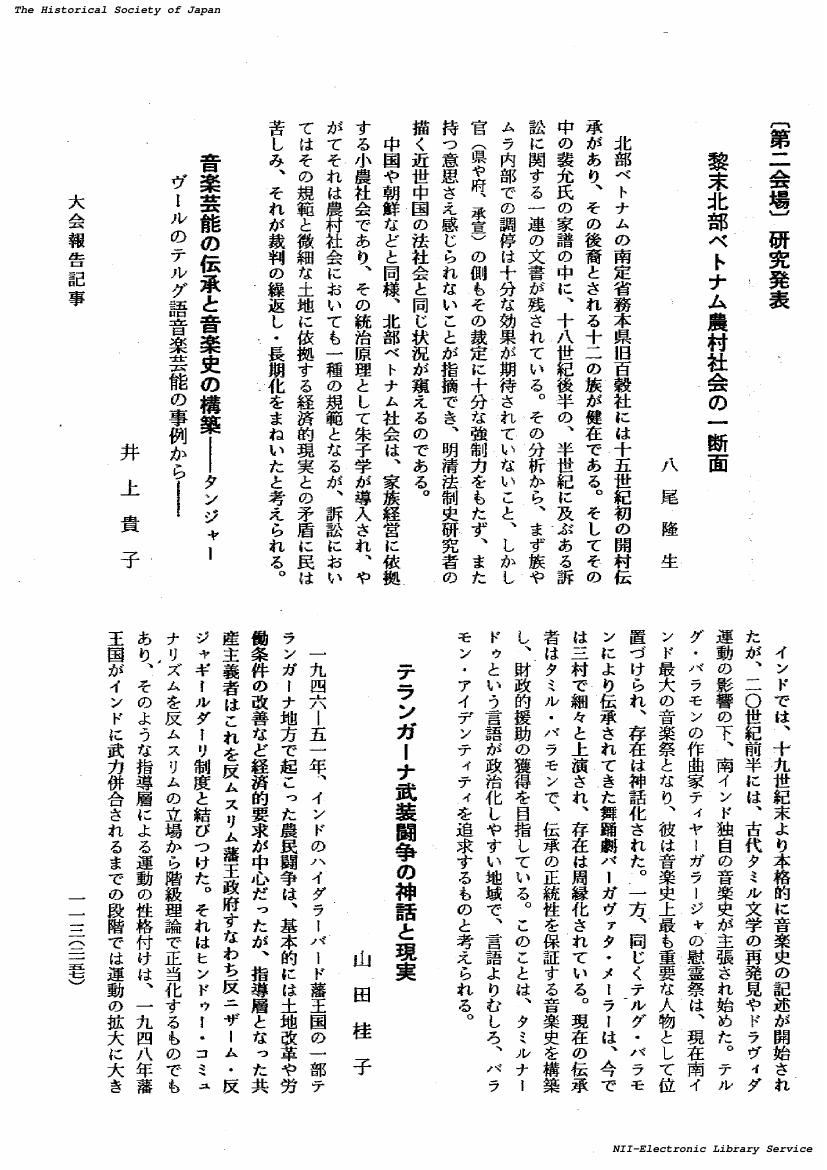2 0 0 0 IR ヴェトナム黎朝期貶資制度の変遷
- 著者
- 八尾 隆生
- 出版者
- 慶應義塾大学言語文化研究所
- 雑誌
- 慶應義塾大学言語文化研究所紀要 (ISSN:03873013)
- 巻号頁・発行日
- no.52, pp.227-242, 2021-03
はじめに一 貶資、貶爵とは二 貶資制度の変遷三 貶資制度の形骸化おわりに研究ノート
2 0 0 0 黎朝聖宗の目指したもの : 十五世紀大越ヴェトナムの對外政策
- 著者
- 八尾 隆生
- 出版者
- 東洋史研究会
- 雑誌
- 東洋史研究 (ISSN:03869059)
- 巻号頁・発行日
- vol.74, no.1, pp.39-75, 2015-06
1 0 0 0 OA 黎末北部ベトナム農村社会の一断面
- 著者
- 八尾 隆生
- 出版者
- 公益財団法人 史学会
- 雑誌
- 史学雑誌 (ISSN:00182478)
- 巻号頁・発行日
- vol.107, no.12, pp.2157, 1998-12-20 (Released:2017-11-30)
1 0 0 0 ヴェトナム黎朝聖宗の明律受容に関する初歩的考察
- 著者
- 八尾 隆生
- 出版者
- 広島史学研究会
- 雑誌
- 史学研究 = Review of historical studies (ISSN:03869342)
- 巻号頁・発行日
- no.293, pp.26-46, 2016-09
1 0 0 0 IR 黎朝聖宗の目指したもの : 十五世紀大越ヴェトナムの對外政策
- 著者
- 八尾 隆生
- 出版者
- 東洋史研究会
- 雑誌
- 東洋史研究 (ISSN:03869059)
- 巻号頁・発行日
- vol.74, no.1, pp.39-75, 2015-06
The first half of the period from 1450 to 1680, which was called "the Age of Commerce" by Anthony Reid, corresponds to the first half of the Le era in Dai Viet (Vietnam). In scholarship on Vietnamese history, the viewpoints of historians who focus on the landmass or a single nation have been the mainstream, so the relations between the outer maritime world in the East and Southeast Asia and the foreign policy of the Le government, especially of the most prosperous reign of King Le Thanh Tong, have yet to be fully analyzed. In recent years, however, the number of studies from the viewpoint of maritime history, using the outcome of the research on ceramics trade and emphasizing the importance of the existence of the Ming empire and the Ryukyu kingdom has increased. This essay will employ the limited number of records in the Vietnamese chronicles and laws as well as information from newly introduced inscriptions to indicate the following points. According to an analysis of the foreign trade policy in the first half of the Le era and the aim of the military expansionist policy of King Thanh Tong, we see that the Le government also took administrative control of foreign trade, issuing a "sea ban" similar to the haijin policy of the Ming, though less rigorously enforced. The government, however, had to cooperate with illegal trade ships that resisted the Ming ban to export new commodities like ceramics. Ryukyu kingdom, which played an important role in the fifteenth century maritime world of Southeast Asia, did not maintain an official trade relationship with Dai Viet because the kingdom had been established as a new trade center with the aid of Ming empire and Dai Viet had continued its dispute with the Ming from the time of its founding. With respect to the military expansion policy of King Thanh Tong, we cannot deny the possibility that he sharpened his consciousness of being a "Middle Kingdom" and succeeded in exploiting commodities from small peripheral "vassal states" in the tribute system for a short time. However, it is not possible to conclude whether his policy of military expansion was closely link to the foreign trade policy because research on this point has been insufficient.
1 0 0 0 OA 黎朝仁宗元号考(文化編)
- 著者
- 八尾 隆生
- 出版者
- 大阪外国語大学
- 雑誌
- 大阪外国語大学論集 (ISSN:09166637)
- 巻号頁・発行日
- vol.13, pp.195-206, 1995-09-29
前近代の中国や朝鮮と同様,15世紀のヴェトナム黎朝の諸皇帝も元号を有していた。第3代仁宗は「太和」と「延寧」の2つの元号を有していたが,「太和」は誤りで,正しくは「大和」であるとする意見が存在する。ヴェトナム前近代史文書史料には後世の抄写本が多いという弱みがあるが,来歴のはっきりしている最古のものは大和としている。次に15世紀オリジナルの碑文はすべて大和としており,偶然発見された同期の仏像にも大和の年号が刻まれていた。さらに銅銭も太和と刻印しているのもあるが私鋳銭と考えられ,現存するあらゆる史料を見る限り,大和が正しいのである。この至極当たり前の事が今まで見過ごされてきたのは,太和の方が人口に膾炙しているという先入観からきたものである。そしてこの先入観から残念ながら現在のヴェトナム史研究者も免れていなかったのである。ヴェトナムでは最近の経済の復調に伴って多くの研究書の出版や史料の復刻企画が為されているが,こういう時こそ原史料に忠実であるという歴史学の原点に立ち戻る必要がある。

